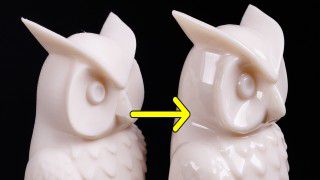รถเข็นของคุณว่างเปล่า!

A Step-by-Step Guide to Paint 3D Prints
- Abdulrahman Alhamed
- 06 Aug 2023
- Protip
- Beginner
- 964
To take your 3D prints to the next level and bring them to life, you'll need to master the art of painting. This article will take you through a step-by-step journey, covering everything from prepping the prints to choosing the right paints and techniques for a flawless finish.
Smoothing

Source: makeitquick
Pre-sanding: Before you begin painting your 3D prints, it's essential to perform pre-sanding. This step involves addressing three main aspects:
- Removing Supports: If your 3D print was generated with support structures, they need to be carefully removed. Support structures are temporary elements that hold up overhanging parts during the printing process. After printing, these supports must be detached, leaving a clean surface ready for sanding and painting.
- Smoothing Visible Imperfections: During the 3D printing process, slight imperfections may arise, such as layer lines, blobs, or gaps. Pre-sanding allows you to identify and smooth out these visible flaws, creating a more refined foundation for the subsequent sanding stage.
- Eliminating Rough Surfaces: Depending on the 3D printing method and material used, the surface of the print might be rough or uneven. Pre-sanding helps in leveling out these rough areas, ensuring a smoother finish for your paint to adhere to.
Sanding Process: After completing the pre-sanding step, you can proceed with the main sanding process. This stage involves the following:
- Selecting Appropriate Sandpaper: Choose sandpaper with a suitable grit, typically starting with a higher grit (e.g., 150-200) for pre-sanding and transitioning to a lower grit (e.g., 400) for the main sanding. The lower grit sandpaper is more effective at smoothing out the print's surface.
- Achieving a Smooth Surface: Using the chosen sandpaper, gently sand the entire surface of the 3D print. Employ a consistent back-and-forth motion to create an even, smooth finish. This step helps to further eliminate any remaining imperfections, ensuring a clean canvas for painting.
Priming

Source: bitfab
Primer is a vital coating applied before painting 3D prints. It prepares the surface by creating a strong bond between the print and the paint. This improves paint adhesion and ensures a smoother and more consistent finish.
Choosing the right primer is essential for successful painting. Consider the type of paint you're using and the material of your 3D print to select a suitable primer that complements both.
Apply the primer in thin, even coats to preserve the fine details of the 3D print. Building up the primer gradually will create an even surface and enhance the overall appearance of your painted 3D prints.
Painting Techniques

Source: howto3dprint
There are different ways to paint 3D prints, each offering unique effects. Brush painting is versatile, allowing for precise details, while airbrushing provides smooth gradients and even coverage. Hand-painting allows for artistic freedom and adding textures. You can also combine techniques for more complex results.
Don't hesitate to experiment with different techniques, strokes, and color combinations. Mix and match to find what works best for your artistic vision. Mastering painting techniques takes practice, so be patient with yourself. As you gain experience, your skills will improve, and your painted 3D prints will become more impressive. Enjoy the process of bringing your creations to life through the art of painting.
Which Paint to Use

Source: justpaint
When choosing paint for your 3D prints, consider factors such as the type of material used (PLA, ABS, etc.) and the desired finish. Acrylic paints are versatile, quick-drying, and suitable for most 3D print materials. For more durable results, enamel paints offer a robust and glossy finish. If you prefer a spray application, aerosol paints provide convenient coverage, especially for larger prints. Experiment with different paint types to find the one that best complements your project and brings out the desired visual appeal in your painted 3D prints.
Conclusion
Painting 3D prints is a rewarding process that brings creativity to life. Pre-sanding and using primer prepare the surface for a smooth canvas. Explore techniques like brush painting and airbrushing for unique effects. Choose the right paint type for your material and finish. With dedication, your 3D prints will impress and inspire. Happy painting!
 International
International Singapore
Singapore Malaysia
Malaysia Thailand
Thailand Vietnam
Vietnam
